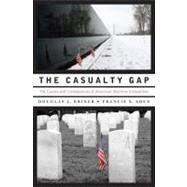
Note: Supplemental materials are not guaranteed with Rental or Used book purchases.
Purchase Benefits
What is included with this book?
| The Casualty Gap | p. 3 |
| The Politics of Casualties | p. 7 |
| Plan of the Book | p. 10 |
| Inequality and U.S. Casualties from WWII to Iraq | p. 14 |
| Studying Casualties and Inequality | p. 16 |
| Defining and Measuring the Casualty Gap | p. 17 |
| Geographic Variance in Local Casualty Rates | p. 18 |
| Explaining the Casualty Gap | p. 22 |
| Income and Education | p. 22 |
| Unemployment | p. 22 |
| Race | p. 23 |
| Rural Farm Population | p. 24 |
| Partisanship | p. 25 |
| Geographic Region and Age | p. 26 |
| Assessing the Casualty Gap across Four Wars | p. 26 |
| The Individual-Level Casualty Gap and the Problem of Ecological Inference | p. 40 |
| Examining Socioeconomic Variation within the Community | p. 43 |
| Explaining the Casualty Gap | p. 47 |
| Technical Appendix to Chapter 2 | p. 48 |
| Selection, Occupational Assignment, and the Emergence of the Casualty Gap | p. 56 |
| Selection in the Modern Wars | p. 58 |
| The War in Iraq and the AVF | p. 63 |
| Occupational Assignment within the Military | p. 67 |
| The Selection Mechanism Revisited: The Role of the Draft | p. 73 |
| Changes in the Draft and in the Casualty Gap over Time | p. 74 |
| The Draft Lottery and Its Ramifications for the Casualty Gap | p. 76 |
| The Absence of a Draft and the Iraq Casualty Gap | p. 78 |
| Casualty Gaps at the Individual Level | p. 80 |
| Technical Appendix to Chapter 3 | p. 83 |
| Do Casualty Gaps Matter? | p. 92 |
| The Casualty Gap and Public Support for War | p. 94 |
| The Casualty Gap's Influence in 2009 | p. 100 |
| Bringing the Casualty Gap into the Public Sphere | p. 103 |
| Technical Appendix to Chapter 4 | p. 104 |
| How Local Casualties Shape Politics | p. 109 |
| Local Casualties and Political Behavior | p. 111 |
| A New Theory of Local Casualty Influence | p. 113 |
| Personal Contact with Local Casualties | p. 113 |
| Elite Cues | p. 117 |
| The Local Media | p. 120 |
| Conclusion | p. 123 |
| Technical Appendix to Chapter 5 | p. 124 |
| Political Ramifications of the Vietnam Casualty Gap | p. 131 |
| Casualties, Public Opinion, and the Vietnam War | p. 133 |
| Local Casualty Rates and Support for the Vietnam War | p. 136 |
| Casualties | p. 136 |
| Demographic Control Variables | p. 137 |
| Results and Discussion | p. 138 |
| Should the United States Have Stayed Out of Vietnam? | p. 138 |
| Should the United States Withdraw from Vietnam? | p. 143 |
| The Electoral Consequences of Local Casualties | p. 146 |
| Modeling Vote Choice | p. 147 |
| Results and Discussion | p. 148 |
| The Casualty Gap and the Democratic Brake on Military Adventurism | p. 153 |
| Technical Appendix to Chapter 6 | p. 155 |
| Political Ramifications of the Iraq Casualty Gap | p. 161 |
| Iraq, Casualties, and Public Opinion | p. 163 |
| Knowing a Casualty and Feeling Negatively Affected Personally by the War | p. 165 |
| Supporr for Withdrawal | p. 167 |
| Iraq, Casualties, and Electoral Dynamics | p. 170 |
| Varying Experience with Casualties and Electoral Choice in 2006 | p. 171 |
| State and Local Casualty Rates and Change in Republican Vote Share | p. 172 |
| State-Level Results | p. 175 |
| County-Level Results | p. 178 |
| Republican Incumbent Races at the County Level | p. 179 |
| Conclusion | p. 181 |
| Technical Appendix to Chapter 7 | p. 183 |
| The Casualty Gap and Civic Engagement | p. 191 |
| War and American Political and Civic Engagement | p. 193 |
| Theoretical Expectations | p. 195 |
| The Immediate Effects of Vietnam on Political Participation | p. 197 |
| Results | p. 198 |
| The Lingering Effects of Vietnam on Civic Engagement | p. 203 |
| Results | p. 204 |
| Korea, World War II, and Patterns of Political Engagement | p. 206 |
| Results | p. 207 |
| Conclusion | p. 211 |
| Technical Appendix to Chapter 8 | p. 213 |
| The Future of the Casualty Gap | p. 226 |
| Responding to the Casualty Gap | p. 231 |
| Facing up to the Casualty Gap | p. 234 |
| Notes | p. 235 |
| References | p. 277 |
| Index | p. 295 |
| Table of Contents provided by Ingram. All Rights Reserved. |
The New copy of this book will include any supplemental materials advertised. Please check the title of the book to determine if it should include any access cards, study guides, lab manuals, CDs, etc.
The Used, Rental and eBook copies of this book are not guaranteed to include any supplemental materials. Typically, only the book itself is included. This is true even if the title states it includes any access cards, study guides, lab manuals, CDs, etc.